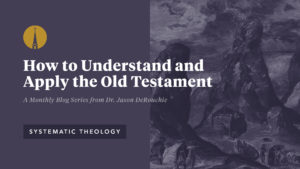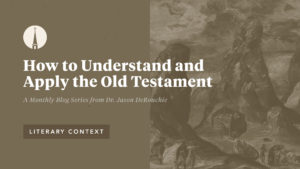
How to Understand and Apply the Old Testament: Step 12––Practical Theology
This is our final installment in this series, and it addresses step 12. Having exegeted the text and grasped God’s intended meaning, you as the interpreter now need to apply it to yourself, the church, and the world, stressing the centrality of Christ and the hope of the gospel. Such is the task of practical theology, by which we seek to live according to the biblical author’s intended effect.

How to Understand and Apply the Old Testament–Step 11: Systematic Theology
In the interpretive process, the stage considering Systematic Theology is asking more specifically, “How does our passage theologically cohere with the whole Bible?” Or, “How does our passage contribute to our understanding of certain doctrines?”

How to Understand and Apply the Old Testament: Step 10––Biblical Theology
Once you have established your text, made accurate observations, and discerned your passage’s contexts, it is time to determine your text’s meaning. To do this, it is critical to understand biblical theology, the discipline that considers how the whole Bible progresses, integrates, and climaxes in Jesus.

How to Understand and Apply the Old Testament: Step 9–Literary Context
As you examine your passage in view of the whole book, there are at least three areas you want to keep in mind: literary placement, literary function, and literary details.

How to Understand and Apply the Old Testament: Step 8–Historical Context
By considering a passage’s historical context, we are asking, “Where does this passage fit in space and time, and how do these data points inform the reading of our passage?”

How to Understand and Apply the Old Testament: Step 7–Word and Concept Studies
This post will overview the key tools, principles, and process for doing word and concept studies in the Old Testament for those without knowledge of Hebrew.

How to Understand and Apply the Old Testament: Step 6–Argument Tracing
“Argument-tracing” is step 6 in understanding and apply the Old Testament. Perhaps more than any other step in the exegetical process, this one helps us grasp a passage’s message. In this post, I will show how to trace the argument of a passage by using an argument-diagram.

How to Understand and Apply the Old Testament: Step 5–Clause and Text Grammar
With step 5 of the interpretive process we move from “Text” to “Observation,” and we consider a series of issues related to how a passage is communicated. Our initial goal is to assess the makeup and relationship of words, phrases, clauses, and larger text units. In short, we need to study grammar. According to His […]

How to Understand and Apply the Old Testament: Step 4–Translation
Whether you know the biblical languages or not, several good English translations will serve you well in studying the Bible and teaching.

How to Understand and Apply the Old Testament: Step 3—Text Criticism
Just as an alert reader can understand a book that has typographical errors in it, so too God’s word is able to speak for itself despite the scribes’ minor corruptions.

